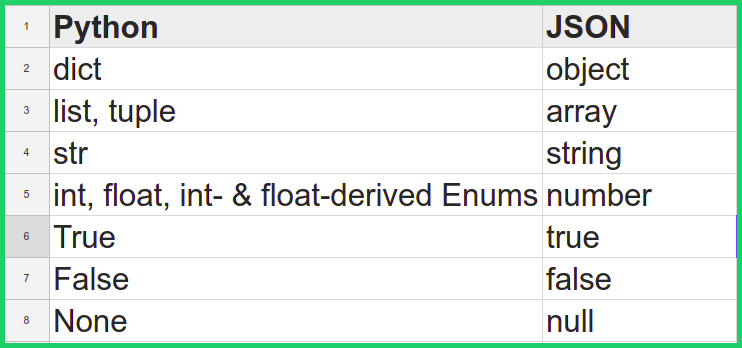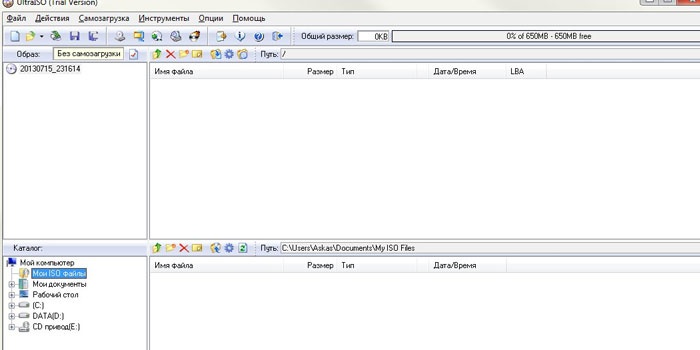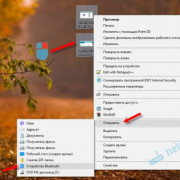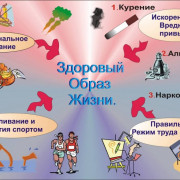Python json: encode(dump), decode(load) json data & file (example)
Содержание:
- Serializing Simple Built-in Datatypes
- Стандартное соответствие и совместимость
- Что такое JSON?
- How to use parse_float and parse_int kwarg in json.load()
- Packaging
- Command Line Interface¶
- Deserializing Simple Built-in Datatypes
- Working with Custom Objects
- 19.2.4. Standard Compliance and Interoperability¶
- Encoders and Decoders¶
- String¶
- Cheat Code
- Пример сериализации JSON Python
- Parse and Retrieve nested JSON array key-values
- Сохранение данных в файл Pickle.
- 19.2.2. Encoders and Decoders¶
- Read JSON data from a file and convert it into dict using json.load()
- Encoders and Decoders¶
- Building Values¶
- Структура JSON
Serializing Simple Built-in Datatypes
By default, the JSON encoder only understands native Python data types (, , , , , , and ). The module provides two very handy methods for serialization based on the conversion table below:

Python — JSON conversion
- — to serialize an object to a JSON formatted string.
- — to serialize an object to a JSON formatted stream ( which supports writing to a file).
Lets look at an example of how to use to serialize built in data types.
>>> import json>>> json.dumps({ "name": "Foo Bar", "age": 78, "friends": , "balance": 345.80, "other_names":("Doe","Joe"), "active":True, "spouse":None }, sort_keys=True, indent=4)
And the output:
{ "active": true, "age": 78, "balance": 345.8, "friends": , "name": "Foo Bar", "other_names": , "spouse": null}
In the example above we passed a dictionary to the method, with 2 extra arguments which provide pretty printing of JSON string. tells the encoder to return the JSON object keys in a sorted order, while the value allows the output to be formatted nicely, both for easy readability.
Similarly, lets use on the same dictionary and write the output stream to a file.
>>> import json>>> with open('user.json','w') as file: json.dump({ "name": "Foo Bar", "age": 78, "friends": , "balance": 345.80, "other_names":("Doe","Joe"), "active":True, "spouse":None }, file, sort_keys=True, indent=4)
This example writes a file to disk with similar content as in the previous example.
Стандартное соответствие и совместимость
Формат JSON указан в RFC 7159 и ECMA-404. В этом разделе описывается уровень соответствия этого модуля с RFC
Для упрощения, подклассы и , и параметры, которые отличаются от указанных, не берутся во внимание
Этот модуль не соответствует RFC, устанавливая некоторые расширения, которые являются рабочими для JavaScript, но недействительными для JSON. В частности:
- и принимаются и выводятся;
- Повторяемые имена внутри объекта принимаются и выводятся, но только последнее значение дублируемого ключа.
Поскольку RFC разрешает синтаксическим анализаторам, совместимым с RFC, принимать входные тексты, которые не соответствуют требованиям RFC, десериализатор этого модуля технически соответствует стандартным настройкам RFC.
Кодировка символов
RFC требует, чтобы JSON был представлен с использованием UTF-8, UTF-16 или UTF-32, при том, что UTF-8 является рекомендуемым по умолчанию для максимальной совместимости.
Возможно, но не обязательно для RFC, сериализаторы этого модуля устанавливают по умолчанию, таким образом строки содержат только символы ASCII.
Кроме параметра , этот модуль напрямую не затрагивает проблему кодировки символов.
RFC запрещает маркер последовательности байтов (BOM) в начало текста JSON и сериализатор этого модуля не добавляет BOM. RFC позволет, не не требует десериализаторы JSON игнорировать BOM на входе. Десериализатор этого модуля вызывает при наличии BOM.
RFC явно не запрещает строки JSON, содержащие последовательность байт, которая не соответствует валидным символам Unicode (например, непарные UTF-16 заменители), он отмечает — они могут вызывать проблемы совместимости. По умолчанию этот модуль принимает и выводит (если есть в исходной строке) специальные последовательности кода.
Infinite и NaN
RFC не допускает представления для значений или . Несмотря на это, по умолчанию этот модуль принимает и выводит , , и , как если бы они были действительно буквальными значениями числа в JSON:
В сериализаторе параметр используется для изменения этого поведения. В десериализаторе параметр этот переметр — .
Повторяющиеся имена внутри объекта
RFC указывает, что имена в объекте JSON должны быть уникальными, но не указывает, как должны обрабатываться повторяющиеся имена в объектах JSON. По умолчанию этот модуль не вызывает исключения; вместо этого он игнорирует все, кроме последней пары ключ/значение для данного ключа:
Параметр может использоваться для изменения этого.
Значение верхнего уровня Non-Object, Non-Array
Старая версия JSON указанная устаревшим RFC 4627 требовала, чтобы значение верхнего уровня текста JSON было объектом JSON или массивом (Python или ), или не было . RFC 7159 убрало это ограничение, поэтому этот модуль не выполнял и никогда не применял это ограничение ни в своем сериализаторе, ни в десериализаторе.
Тем не менее, для максимальной совместимости, вы можете добровольно придерживаться этого ограничения.
Ограничения реализации
Некоторые реализации десериализатора JSON имеют лимиты на:
- размер принимаемого текста JSON
- максимальный уровень вложенности объектов и массивов JSON
- диапазон и точность чисел JSON
- содержание и максимальная длина строк JSON
Этот модуль не ставит никаких ограничений, кроме тех, которые относятся к соответствующим типам Python или самому интерпретатору Python.
При сериализации в JSON будьте осторожны с такими ограничениями в приложениях, которые могут потреблять ваш JSON. В частности, числа в JSON часто десериализуются в числа двойной точности IEEE 754 и подвержены ограничениям диапазона и точности этого представления. Это особенно актуально при сериализации значений Python чрезвычайно большой величины или при сериализации экземпляров «необычных» числовых типов, таких как .
Что такое JSON?
Информация в формате JSON может быть представлена в двух видах:
- Последовательность пар с ключами и соответствующими им значениями;
- Просто упорядоченный набор значений.
Как правило, любой высокоуровневый язык программирования поддерживает эти структуры данных. Значения, которые передаются в JSON, могут являться объектами, строками, числами, одномерными массивами, а также литералами (true, false, null). Python поддерживает работу с форматом JSON, благодаря модулю json и методам по кодированию и декодированию данных. Это позволяет легко получать и отправлять информацию в комфортном для чтения виде.
How to use parse_float and parse_int kwarg in json.load()
As I already told and , both are optional parameters but, if specified, will be called with the string of every JSON float and integer to be decoded. By default, this is equivalent to and .
Suppose the JSON document contains many float values, and you want to round all float values to two decimal-point. In this case, we need to define a custom function that performs whatever rounding you desire. We can pass such a function to kwarg.
Also, if you wanted to perform any operation on integer values, we could write a custom function and pass it to kwarg. For example, you received leave days in the JSON document, and you want to calculate the salary to deduct.
We are using the following JSON file for this example.
Insert image.
Output:
Load float and int values from JSON and manipulate it Started Reading JSON file Salary: 9250.542 <class 'float'> Salary to deduct: 3 Done reading a JSON file
Packaging
rustup default nightly pip wheel --no-binary=orjson orjson
This is an example of building a wheel using the repository as source,
installed from upstream, and a pinned version of Rust:
pip install maturin curl https://sh.rustup.rs -sSf | sh -s -- --default-toolchain nightly-2020-10-24 --profile minimal -y maturin build --no-sdist --release --strip --manylinux off ls -1 target/wheels
Problems with the Rust nightly channel may require pinning a version.
is known to be ok.
orjson is tested for amd64 and aarch64 on Linux, macOS, and Windows. It
may not work on 32-bit targets. It should be compiled with
on amd64 and on arm7. musl
libc is not supported, but building with
will probably work. The recommended flags are specified in
and will apply unless is set.
There are no runtime dependencies other than libc.
orjson’s tests are included in the source distribution on PyPI. It is
necessarily to install dependencies from PyPI specified in
. These require a C compiler. The tests do not
make network requests.
The tests should be run as part of the build. It can be run like this:
pip install -r test/requirements.txt pytest -q test
Command Line Interface¶
Source code: Lib/json/tool.py
The module provides a simple command line interface to validate
and pretty-print JSON objects.
If the optional and arguments are not
specified, and will be used respectively:
$ echo '{"json": "obj"}' | python -m json.tool
{
"json": "obj"
}
$ echo '{1.2:3.4}' | python -m json.tool
Expecting property name enclosed in double quotes: line 1 column 2 (char 1)
Changed in version 3.5: The output is now in the same order as the input. Use the
option to sort the output of dictionaries
alphabetically by key.
Command line options
-
The JSON file to be validated or pretty-printed:
$ python -m json.tool mp_films.json { "title": "And Now for Something Completely Different", "year": 1971 }, { "title": "Monty Python and the Holy Grail", "year": 1975 }If infile is not specified, read from .
-
Write the output of the infile to the given outfile. Otherwise, write it
to .
-
Sort the output of dictionaries alphabetically by key.
New in version 3.5.
-
Show the help message.
Footnotes
-
As noted in the errata for RFC 7159,
JSON permits literal U+2028 (LINE SEPARATOR) and
U+2029 (PARAGRAPH SEPARATOR) characters in strings, whereas JavaScript
(as of ECMAScript Edition 5.1) does not.
Deserializing Simple Built-in Datatypes
As in the case of serialization, the decoder converts JSON encoded data into native Python data types as in the table below:
JSON — Python conversion
The module exposes two other methods for deserialization.
- — to deserialize a JSON document to a Python object.
- — to deserialize a JSON formatted stream ( which supports reading from a file) to a Python object.
>>> import json>>> json.loads('{ "active": true, "age": 78, "balance": 345.8, "friends": , "name": "Foo Bar", "other_names": ,"spouse":null}')
And the output:
{'active': True, 'age': 78, 'balance': 345.8, 'friends': , 'name': 'Foo Bar', 'other_names': , 'spouse': None}
Here we passed a JSON string to the method, and got a dictionary as the output.To demonstrate how works, we could read from the file that we created during serialization in the previous section.
>>> import json>>> with open('user.json', 'r') as file: user_data = json.load(file)>>> print(user_data)
From this example, we get a dictionary, again, similar to the one in above.
Working with Custom Objects
So far we’ve only worked with built-in data types. However, in real world applications, we often need to deal with custom objects. We will look at how to go about serializing and deserializing custom objects.
19.2.4. Standard Compliance and Interoperability¶
The JSON format is specified by RFC 7159 and by
ECMA-404.
This section details this module’s level of compliance with the RFC.
For simplicity, and subclasses, and
parameters other than those explicitly mentioned, are not considered.
This module does not comply with the RFC in a strict fashion, implementing some
extensions that are valid JavaScript but not valid JSON. In particular:
- Infinite and NaN number values are accepted and output;
- Repeated names within an object are accepted, and only the value of the last
name-value pair is used.
Since the RFC permits RFC-compliant parsers to accept input texts that are not
RFC-compliant, this module’s deserializer is technically RFC-compliant under
default settings.
19.2.4.1. Character Encodings
The RFC requires that JSON be represented using either UTF-8, UTF-16, or
UTF-32, with UTF-8 being the recommended default for maximum interoperability.
As permitted, though not required, by the RFC, this module’s serializer sets
ensure_ascii=True by default, thus escaping the output so that the resulting
strings only contain ASCII characters.
Other than the ensure_ascii parameter, this module is defined strictly in
terms of conversion between Python objects and
, and thus does not otherwise directly address
the issue of character encodings.
The RFC prohibits adding a byte order mark (BOM) to the start of a JSON text,
and this module’s serializer does not add a BOM to its output.
The RFC permits, but does not require, JSON deserializers to ignore an initial
BOM in their input. This module’s deserializer raises a
when an initial BOM is present.
The RFC does not explicitly forbid JSON strings which contain byte sequences
that don’t correspond to valid Unicode characters (e.g. unpaired UTF-16
surrogates), but it does note that they may cause interoperability problems.
By default, this module accepts and outputs (when present in the original
) code points for such sequences.
19.2.4.2. Infinite and NaN Number Values
The RFC does not permit the representation of infinite or NaN number values.
Despite that, by default, this module accepts and outputs ,
, and as if they were valid JSON number literal values:
>>> # Neither of these calls raises an exception, but the results are not valid JSON
>>> json.dumps(float('-inf'))
'-Infinity'
>>> json.dumps(float('nan'))
'NaN'
>>> # Same when deserializing
>>> json.loads('-Infinity')
-inf
>>> json.loads('NaN')
nan
In the serializer, the allow_nan parameter can be used to alter this
behavior. In the deserializer, the parse_constant parameter can be used to
alter this behavior.
19.2.4.3. Repeated Names Within an Object
The RFC specifies that the names within a JSON object should be unique, but
does not mandate how repeated names in JSON objects should be handled. By
default, this module does not raise an exception; instead, it ignores all but
the last name-value pair for a given name:
>>> weird_json = '{"x": 1, "x": 2, "x": 3}'
>>> json.loads(weird_json)
{'x': 3}
The object_pairs_hook parameter can be used to alter this behavior.
19.2.4.4. Top-level Non-Object, Non-Array Values
The old version of JSON specified by the obsolete RFC 4627 required that
the top-level value of a JSON text must be either a JSON object or array
(Python or ), and could not be a JSON null,
boolean, number, or string value. RFC 7159 removed that restriction, and
this module does not and has never implemented that restriction in either its
serializer or its deserializer.
Regardless, for maximum interoperability, you may wish to voluntarily adhere
to the restriction yourself.
Encoders and Decoders¶
- class (*, object_hook=None, parse_float=None, parse_int=None, parse_constant=None, strict=True, object_pairs_hook=None)
-
Simple JSON decoder.
Performs the following translations in decoding by default:
JSON
Python
object
dict
array
list
string
str
number (int)
int
number (real)
float
true
True
false
False
null
None
It also understands , , and as their
corresponding values, which is outside the JSON spec.object_hook, if specified, will be called with the result of every JSON
object decoded and its return value will be used in place of the given
. This can be used to provide custom deserializations (e.g. to
support JSON-RPC class hinting).object_pairs_hook, if specified will be called with the result of every
JSON object decoded with an ordered list of pairs. The return value of
object_pairs_hook will be used instead of the . This
feature can be used to implement custom decoders. If object_hook is also
defined, the object_pairs_hook takes priority.Changed in version 3.1: Added support for object_pairs_hook.
parse_float, if specified, will be called with the string of every JSON
float to be decoded. By default, this is equivalent to .
This can be used to use another datatype or parser for JSON floats
(e.g. ).parse_int, if specified, will be called with the string of every JSON int
to be decoded. By default, this is equivalent to . This can
be used to use another datatype or parser for JSON integers
(e.g. ).parse_constant, if specified, will be called with one of the following
strings: , , .
This can be used to raise an exception if invalid JSON numbers
are encountered.If strict is false ( is the default), then control characters
will be allowed inside strings. Control characters in this context are
those with character codes in the 0–31 range, including (tab),
, and .If the data being deserialized is not a valid JSON document, a
will be raised.Changed in version 3.6: All parameters are now .
- (s)
-
Return the Python representation of s (a instance
containing a JSON document).will be raised if the given JSON document is not
valid.
- (s)
-
Decode a JSON document from s (a beginning with a
JSON document) and return a 2-tuple of the Python representation
and the index in s where the document ended.This can be used to decode a JSON document from a string that may have
extraneous data at the end.
String¶
Jansson uses UTF-8 as the character encoding. All JSON strings must be
valid UTF-8 (or ASCII, as it’s a subset of UTF-8). Normal null
terminated C strings are used, so JSON strings may not contain
embedded null characters. All other Unicode codepoints U+0001 through
U+10FFFF are allowed.
- *json_string(const char *value)
-
Return value: New reference.
Returns a new JSON string, or NULL on error. value must be a
valid UTF-8 encoded Unicode string.
- *json_string_nocheck(const char *value)
-
Return value: New reference.
Like , but doesn’t check that value is valid
UTF-8. Use this function only if you are certain that this really
is the case (e.g. you have already checked it by other means).
- const char *json_string_value(const *string)
-
Returns the associated value of string as a null terminated UTF-8
encoded string, or NULL if string is not a JSON string.The retuned value is read-only and must not be modified or freed by
the user. It is valid as long as string exists, i.e. as long as
its reference count has not dropped to zero.
- int json_string_set(const *string, const char *value)
-
Sets the associated value of string to value. value must be a
valid UTF-8 encoded Unicode string. Returns 0 on success and -1 on
error.
Cheat Code
|
json.dumps(person_data) |
Create JSON Object |
|
json.dump(person_data, file_write) |
Create JSON File using File I/O of Python |
|
compact_obj = json.dumps(data, separators=(‘,’,’:’)) |
Compact JSON Object by removing space character from JSON Object using separator |
|
formatted_obj = json.dumps(dic, indent=4, separators=(‘,’, ‘: ‘)) |
Formatting JSON code using Indent |
|
sorted_string = json.dumps(x, indent=4, sort_keys=True) |
Sorting JSON object key by alphabetic order |
|
complex_obj = json.dumps(4 + 5j, default=complex_encode) |
Python Complex Object encoding in JSON |
|
JSONEncoder().encode(colour_dict) |
Use of JSONEncoder Class for Serialization |
|
json.loads(data_string) |
Decoding JSON String in Python dictionary using json.loads() function |
|
json.loads(‘{«__complex__»: true, «real»: 4, «img»: 5}’, object_hook = is_complex) |
Decoding of complex JSON object to Python |
|
JSONDecoder().decode(colour_string) |
Use of Decoding JSON to Python with Deserialization |
Пример сериализации JSON Python
Представьте, что вы работаете с объектом Python в памяти, который выглядит следующим образом:
data_file.json
Python
data = {
«president»: {
«name»: «Zaphod Beeblebrox»,
«species»: «Betelgeusian»
}
}
|
1 |
data={ «president»{ «name»»Zaphod Beeblebrox», «species»»Betelgeusian» } } |
Сохранить эту информацию на диск — критично, так что ваша задача — записать на файл.
Используя контекстный менеджер Python, вы можете создать файл под названием data_file.json и открыть его в режиме write (файлы JSON имеют расширение .json).
Python
with open(«data_file.json», «w») as write_file:
json.dump(data, write_file)
|
1 |
withopen(«data_file.json»,»w»)aswrite_file json.dump(data,write_file) |
Обратите внимание на то, что dump() принимает два позиционных аргумента: (1) объект данных, который сериализуется и (2), файловый объект, в который будут вписаны байты. Или, если вы склонны продолжать использовать эти сериалзированные данные JSON в вашей программе, вы можете работать как со строкой
Или, если вы склонны продолжать использовать эти сериалзированные данные JSON в вашей программе, вы можете работать как со строкой.
Python
json_string = json.dumps(data)
| 1 | json_string=json.dumps(data) |
Обратите внимание, что файловый объект является пустым, так как вы на самом деле не выполняете запись на диск. Кроме того, dumps() аналогичен dump()
Ура! У вас получился малыш JSON и вы можете выпустить его в реальный мир, чтобы он вырос большим и сильным.
Несколько полезных аргументов
Помните, что JSON создан таким образом, чтобы быть читаемым для людей. Но читаемого синтаксиса недостаточно, если все слеплено вместе. Кроме этого, ваш стиль программирования скорее всего отличается от моего, и вам будет проще читать код, если он отформатирован по вашему вкусу.
Первая опция, которую большинство людей хотят поменять, это пробел. Вы можете использовать аргумент indent для определения размера отступа вложенных структур. Ощутите разницу лично, используя данные, упомянутые выше и выполните следующие команды в консоли:
Python
json.dumps(data)
json.dumps(data, indent=4)
|
1 |
json.dumps(data) json.dumps(data,indent=4) |
Еще один вариант форматирования — это аргумент separators. По умолчанию, это двойной кортеж строк разделителя («, «, «: «), но обычно в качестве альтернативы для компактного JSON является («,», «:»). Взгляните на пример JSON еще раз, чтобы понять, где в игру вступают разделители.
Есть и другие аргументы, такие как sort_keys, но я не имею понятия, что он делает. Вы можете найти полный список в , если вам интересно.
Parse and Retrieve nested JSON array key-values
Let’s assume that you’ve got a JSON response that looks like this:
developerInfo = """{
"id": 23,
"name": "jane doe",
"salary": 9000,
"email": "JaneDoe@pynative.com",
"experience": {"python":5, "data Science":2},
"projectinfo":
}
"""
For example, You want to retrieve the project name from the developer info JSON array to get to know on which project he/she is working. Let’s see now how to read nested JSON array key-values.
In this example, we are using a developer info JSON array, which has project info and experience as nested JSON data.
Output:
Started reading nested JSON array Project name: Data Mining Experience: 5 Done reading nested JSON Array
Сохранение данных в файл Pickle.
Модуль Pickle работает со структурами данных. Давайте создадим одну.
>>> shell 1 ①>>> entry = {} ②>>> entry’title’ = ‘Dive into history, 2009 edition’>>> entry’article_link’ = ‘http://diveintomark.org/archives/2009/03/27/dive-into-history-2009-edition’>>> entry’comments_link’ = None>>> entry’internal_id’ = b’\xDE\xD5\xB4\xF8′>>> entry’tags’ = (‘diveintopython’, ‘docbook’, ‘html’)>>> entry’published’ = True>>> import time>>> entry’published_date’ = time.strptime(‘Fri Mar 27 22:20:42 2009′) ③>>> entry’published_date’ time.struct_time(tm_year=2009, tm_mon=3, tm_mday=27, tm_hour=22, tm_min=20, tm_sec=42, tm_wday=4, tm_yday=86, tm_isdst=-1)
① Все дальнейшее происходит в консоли Python #1.
② Идея в том чтобы создать словарь, который будет представлять что-нибудь полезное, например элемент рассылки Atom. Также я хочу быть уверенным, что он содержит несколько разных типов данных, чтобы раскрыть возможности модуля pickle. Не вчитывайтесь слишком сильно в эти переменные.
③ Модуль time содержит структуру данных (struct_time) для представления момента времени (вплоть до миллисекунд) и функции для работы с этими структурами. Функция strptime() принимает на вход форматированную строку и преобразует ее в struct_time. Эта строка в стандартном формате, но вы можете контролировать ее при помощи кодов форматирования. Для более подробного описания загляните в модуль time.
Теперь у нас есть замечательный словарь. Давайте сохраним его в файл.
>>> shell ①1>>> import pickle>>> with open(‘entry.pickle’, ‘wb’) as f: ②
… pickle.dump(entry, f) ③
…
① Мы все еще в первой консоли
② Используйте функцию open() для того чтобы открыть файл. Установим режим работы с файлом в ‘wb’ для того чтобы открыть файл для записи в двоичном режиме. Обернем его в конструкцию with для того чтобы быть уверенным в том что файл закроется автоматически, когда вы завершите работу с ним.
③ Функция dump() модуля pickle принимает сериализуемую структуру данных Python, сериализует ее в двоичный, Python-зависимый формат использует последнюю версию протокола pickle и сохраняет ее в открытый файл.
Последнее предложение было очень важным.
- Протокол pickle зависит от Python; здесь нет гарантий совместимости с другими языками. Вы возможно не сможете взять entry.pickle файл, который только что сделали и как — либо с пользой его использовать при помощи Perl, PHP, Java или любого другого языка программирования
- Не всякая структура данных Python может быть сериализована модулем Pickle. Протокол pickle менялся несколько раз с добавлением новых типов данных в язык Python, и все еще у него есть ограничения.
- Как результат, нет гарантии совместимости между разными версиями Python. Новые версии Python поддерживают старые форматы сериализации, но старые версии Python не поддерживают новые форматы (поскольку не поддерживают новые форматы данных)
- Пока вы не укажете иное, функции модуля pickle будут использовать последнюю версию протокола pickle. Это сделано для уверенности в том, что вы имеете наибольшую гибкость в типах данных, которые вы можете сериализовать, но это также значит, что результирующий файл будет невозможно прочитать при помощи старых версий Python, которые не поддерживают последнюю версию протокола pickle.
- Последняя версия протокола pickle это двоичный формат. Убедитесь, что открываете файлы pickle в двоичном режиме, или данные будут повреждены при записи.
19.2.2. Encoders and Decoders¶
- class (object_hook=None, parse_float=None, parse_int=None, parse_constant=None, strict=True, object_pairs_hook=None)
-
Simple JSON decoder.
Performs the following translations in decoding by default:
JSON Python object dict array list string str number (int) int number (real) float true True false False null None It also understands , , and as their
corresponding values, which is outside the JSON spec.object_hook, if specified, will be called with the result of every JSON
object decoded and its return value will be used in place of the given
. This can be used to provide custom deserializations (e.g. to
support JSON-RPC class hinting).object_pairs_hook, if specified will be called with the result of every
JSON object decoded with an ordered list of pairs. The return value of
object_pairs_hook will be used instead of the . This
feature can be used to implement custom decoders that rely on the order
that the key and value pairs are decoded (for example,
will remember the order of insertion). If
object_hook is also defined, the object_pairs_hook takes priority.Changed in version 3.1: Added support for object_pairs_hook.
parse_float, if specified, will be called with the string of every JSON
float to be decoded. By default, this is equivalent to .
This can be used to use another datatype or parser for JSON floats
(e.g. ).parse_int, if specified, will be called with the string of every JSON int
to be decoded. By default, this is equivalent to . This can
be used to use another datatype or parser for JSON integers
(e.g. ).parse_constant, if specified, will be called with one of the following
strings: , , .
This can be used to raise an exception if invalid JSON numbers
are encountered.If strict is false ( is the default), then control characters
will be allowed inside strings. Control characters in this context are
those with character codes in the 0–31 range, including (tab),
, and .If the data being deserialized is not a valid JSON document, a
will be raised.- (s)
-
Return the Python representation of s (a instance
containing a JSON document).will be raised if the given JSON document is not
valid.
- (s)
-
Decode a JSON document from s (a beginning with a
JSON document) and return a 2-tuple of the Python representation
and the index in s where the document ended.This can be used to decode a JSON document from a string that may have
extraneous data at the end.
Read JSON data from a file and convert it into dict using json.load()
Using a method, we can read JSON data from text, JSON, or binary file. The method returns data in the form of a Python dictionary. Later we use this dictionary to access and manipulate data in our application or system.
Now, let’s see the example. For this example, I am reading the “developer.json” file present on my hard drive. This file contains the following JSON data.
{
"name": "jane doe",
"salary": 9000,
"skills": ,
"email": "JaneDoe@pynative.com",
"projects":
}
Developer JSON file
Output:
Started Reading JSON file Converting JSON encoded data into Python dictionary Decoded JSON Data From File name : jane doe salary : 9000 skills : email : JaneDoe@pynative.com projects : Done reading json file
Access JSON data directly using key name
Use the following code If you want to access the JSON key directly instead of iterating the entire JSON from a file
Output:
Started Reading JSON file Converting JSON encoded data into Python dictionary Decoding JSON Data From File Printing JSON values using key jane doe 9000 JaneDoe@pynative.com Done reading json file
You can read the JSON data from text, json, or a binary file using the same way mentioned above.
Encoders and Decoders¶
- class (*, object_hook=None, parse_float=None, parse_int=None, parse_constant=None, strict=True, object_pairs_hook=None)
-
Simple JSON decoder.
Performs the following translations in decoding by default:
JSON
Python
object
dict
array
list
string
str
number (int)
int
number (real)
float
true
True
false
False
null
None
It also understands , , and as their
corresponding values, which is outside the JSON spec.object_hook, if specified, will be called with the result of every JSON
object decoded and its return value will be used in place of the given
. This can be used to provide custom deserializations (e.g. to
support JSON-RPC class hinting).object_pairs_hook, if specified will be called with the result of every
JSON object decoded with an ordered list of pairs. The return value of
object_pairs_hook will be used instead of the . This
feature can be used to implement custom decoders. If object_hook is also
defined, the object_pairs_hook takes priority.Changed in version 3.1: Added support for object_pairs_hook.
parse_float, if specified, will be called with the string of every JSON
float to be decoded. By default, this is equivalent to .
This can be used to use another datatype or parser for JSON floats
(e.g. ).parse_int, if specified, will be called with the string of every JSON int
to be decoded. By default, this is equivalent to . This can
be used to use another datatype or parser for JSON integers
(e.g. ).parse_constant, if specified, will be called with one of the following
strings: , , .
This can be used to raise an exception if invalid JSON numbers
are encountered.If strict is false ( is the default), then control characters
will be allowed inside strings. Control characters in this context are
those with character codes in the 0–31 range, including (tab),
, and .If the data being deserialized is not a valid JSON document, a
will be raised.Changed in version 3.6: All parameters are now .
- (s)
-
Return the Python representation of s (a instance
containing a JSON document).will be raised if the given JSON document is not
valid.
- (s)
-
Decode a JSON document from s (a beginning with a
JSON document) and return a 2-tuple of the Python representation
and the index in s where the document ended.This can be used to decode a JSON document from a string that may have
extraneous data at the end.
Building Values¶
This section describes functions that help to create, or pack,
complex JSON values, especially nested objects and arrays. Value
building is based on a format string that is used to tell the
functions about the expected arguments.
For example, the format string "i" specifies a single integer
value, while the format string "" or the equivalent "" specifies an array value with two strings and a boolean as its
items:
/* Create the JSON integer 42 */
json_pack("i", 42);
/* Create the JSON array */
json_pack("", "foo", "bar", 1);
Here’s the full list of format characters. The type in parentheses
denotes the resulting JSON type, and the type in brackets (if any)
denotes the C type that is expected as the corresponding argument.
- s (string)
- Convert a NULL terminated UTF-8 string to a JSON string.
- n (null)
- Output a JSON null value. No argument is consumed.
- b (boolean)
- Convert a C int to JSON boolean value. Zero is converted
to false and non-zero to true. - i (integer)
- Convert a C int to JSON integer.
- I (integer)
- Convert a C to JSON integer.
- f (real)
- Convert a C double to JSON real.
- o (any value)
- Output any given JSON value as-is. If the value is added to an
array or object, the reference to the value passed to o is
stolen by the container. - O (any value)
- Like o, but the argument’s reference count is incremented.
This is useful if you pack into an array or object and want to
keep the reference for the JSON value consumed by O to
yourself. - (array)
- Build an array with contents from the inner format string. fmt
may contain objects and arrays, i.e. recursive value building is
supported. - {fmt} (object)
- Build an object with contents from the inner format string
fmt. The first, third, etc. format character represent a key,
and must be s (as object keys are always strings). The second,
fourth, etc. format character represent a value. Any value may be
an object or array, i.e. recursive value building is supported.
The following functions compose the value building API:
- *json_pack(const char *fmt, …)
-
Return value: New reference.
Build a new JSON value according to the format string fmt. For
each format character (except for {}[]n), one argument is
consumed and used to build the corresponding value. Returns NULL
on error.
- *json_pack_ex( *error, size_t flags, const char *fmt, …)
- *json_vpack_ex( *error, size_t flags, const char *fmt, va_list ap)
-
Return value: New reference.
Like , but an in the case of an error, an error
message is written to error, if it’s not NULL. The flags
parameter is currently unused and should be set to 0.As only the errors in format string (and out-of-memory errors) can
be caught by the packer, these two functions are most likely only
useful for debugging format strings.
More examples:
Структура JSON
Готовьтесь. Я собираюсь показать реальный пример JSON— такой же, какой вы встретите в реальной жизни. Это нормально, подразумевается что JSON является читаемым для любого, кто пользовался С-языками, а Python – это С-язык, так что мы говорим о вас!
Python
{
«firstName»: «Jane»,
«lastName»: «Doe»,
«hobbies»: ,
«age»: 35,
«children»:
}
|
1 |
{ «firstName»»Jane», «lastName»»Doe», «hobbies»»running»,»sky diving»,»singing», «age»35, «children» { «firstName»»Alice», «age»6 }, { «firstName»»Bob», «age»8 } } |
Как видите, JSON поддерживает примитивные типы, такие как строки python и числа, а также вложенные и объекты.
НУ что же, вы пережили первый контакт с диким JSON. Теперь вам нужно научиться приручать его!









